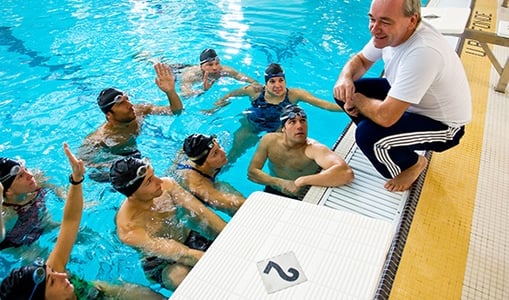
The US Women’s Soccer Team coverage brought me back to my own experiences as an athlete in my youth. As I mentioned in my previous blog, it made me think about how the adoption of Title IX in 1972 created opportunities for me and other girls. This mandate created opportunity and changed lives.
I was a high school varsity athlete in both soccer and swimming who excelled because of drive more so than raw talent. I think about the coaching that I received and my achievements in each of those sports—these two coaches had very different approaches to developing their athletes.
My soccer coach promoted me to the varsity squad before my time. I was fast and intense. I could really kick that ball and kick it far up field. My soccer coach loved that we had a talented team. His way of “growing us” as athletes was to yell and kick the first aid kit when things went awry. When I was on the field, I knew that if he was yelling or kicking that first aid kit that I needed to run faster and kick the ball harder. Unfortunately for me, I was limited by my complete lack of ball-handling skills (kind of important in soccer). My coach didn’t make me play smarter, or more purposefully. I lacked knowledge and was not guided through reflection of my craft. To this day, if a ball comes my way, I either kick the heck out of it or trap the ball so I can kick the heck out of it. I couldn’t and still can’t handle that stinking ball.
My swimming coach “Hank” was completely different. He was an accomplished swimmer during his own youth. He had a calm and reassuring presence at all times. We did see him sweat, but only because we were in hot and humid indoor pool facilities. He was never flustered and always reassured his athletes. Hank spent countless hours organizing his training plan and rosters. He was a scientist (in fact he taught high school sciences). He explained training and nutrition to us young athletes and stretched our capabilities by entering us in events that we would never have chosen on our own (hello, 400 IM!). I remember so clearly how he would have us sit on the bleachers so he could explain aerodynamics and “lift” as it relates to air flight. He would physically move our arms so we could understand what our strokes should feel like. He talked to us about our breathing patterns and how to minimize resistance in the pool. He was intentional about developing our knowledge of our craft. He gave us immediate, honest, and constructive feedback after each race. Races ended after reflection, not when we hit the wall. His mantras were “Do it right before you do it fast" and “Practice doesn’t make perfect; perfect practice makes perfect.” Hank’s coaching made me think about how I was doing what I was doing more than driving me to do things faster or harder. This ultimately led to finishing races faster and faster.
Both my soccer and swimming coaches were effective in their own rights. Both developed college-bound athletes and both collected state accolades. But, for me, Hank maximized my potential. I could definitely accept that I was doomed to mediocrity in soccer. I also know that in soccer, I only knew to respond to coaching by running faster and kicking harder. In swimming, I thought about the science behind getting from one end of the pool to the other as efficiently as possible.
So, whether on the soccer field, around the pool, or in the classroom, I urge you to ask yourself what kind of coach you are and what kind of coach you aspire to be. How do you maximize potential and optimize learning? How do you impart knowledge and guide reflection? And, in the absence of that pesky mandate of 1972, what kind of story would I be able to tell?

